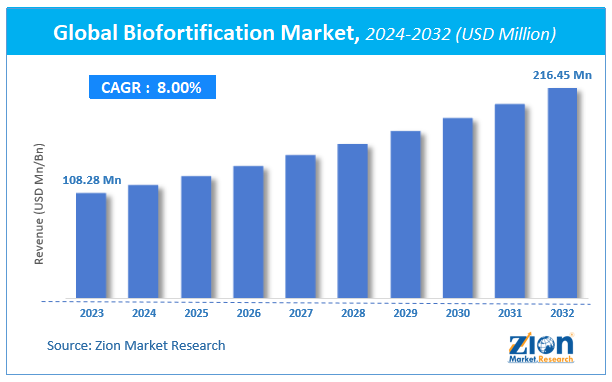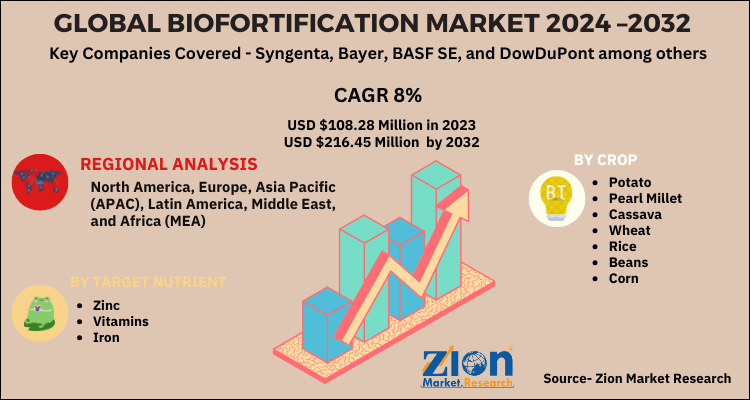Biofortification Market Size, Share, Trends, Growth and Forecast 2032

Biofortification Market By Crop (Potato, Pearl Millet, Cassava, Wheat, Rice, Beans, and Corn), By Target Nutrient (Zinc, Vitamins, and Iron): Global Industry Perspective, Comprehensive Analysis and Forecast, 2024 - 2032-
| Market Size in 2023 | Market Forecast in 2032 | CAGR (in %) | Base Year |
|---|---|---|---|
| USD 108.28 Million | USD 216.45 Million | 8% | 2023 |
Biofortification Market Insights
According to Zion Market Research, the global Biofortification Market was worth USD 108.28 Million in 2023. The market is forecast to reach USD 216.45 Million by 2032, growing at a compound annual growth rate (CAGR) of 8% during the forecast period 2024-2032.
The report offers a comprehensive analysis of the market, highlighting the factors that will determine growth, potential challenges, and opportunities that could emerge in the Biofortification industry over the next decade.
Global Biofortification Market: Overview
Biofortification is another way by which crops are breed to upgrade their healthy benefit. It varies from customary fortress as Biofortification focuses on creating progressively nutritious plant sustenance’s over the way toward including supplements in the nourishments.
Biofortification is a new concept in which crops are breed to enhance their nutritional value. It differs from conventional fortification as Biofortification concentrates on producing more nutritious plant foods over the process of adding nutrients in the foods after food processing. In fact, Biofortification is a strategy that deals with micronutrient deficits across the emerging economies. Biofortification uses three methods, namely, selective breeding, seed priming, and genetic modification to enhance the nutritional value of the food in plants
Global Biofortification Market: Growth Factors
Increase in capital funding for agronomic activities and technological advancements are anticipated to spur the growth trends for Biofortification market in the coming years. Massive use of Biofortification in yields such as beans, wheat, corn, sweet potato, cassava, rice, and pearl millet are anticipated to impel the business growth in the ensuing years.
In addition enormous application of Biofortification in tomato, banana, sorghum, and barley to enhance their nutritional value will create lucrative growth avenues for Biofortification market in the forthcoming years. Micronutrient deficiency most commonly affects the population in the developing regions and most of the people in these economies are affected due to iron, zinc, and vitamin A deficiencies. However, Biofortification enhances the micronutrient proportions in staple foods and helps in reducing the micronutrient deficiencies in population and mostly children.
This, in turn, has produced huge demand for Biofortification in the emerging economies. In addition, Biofortification is inexpensive and the costs of implementation of cultivating biofortified foods are negligible. This, in turn, will further drive Biofortification market revenue in the coming years. With growing demand for food with high nutritional content for improving the physical as well as intellectual growth in children will catapult Biofortification market size over the next few years.
Global Biofortification Market: Segmentation
The global Biofortification market can be divided based on Crop and Target Nutrient.
Based on the crop, the market can be segmented into sweet potato, pearl millet, cassava, wheat, rice, beans, and corn.
On the basis of target nutrient, the market can be divided into zinc, vitamins, and iron.
Biofortification Market: Report Scope
| Report Attributes | Report Details |
|---|---|
| Report Name | Biofortification Market |
| Market Size in 2023 | USD 108.28 Million |
| Market Forecast in 2032 | USD 216.45 Million |
| Growth Rate | CAGR of 8% |
| Number of Pages | 110 |
| Key Companies Covered | Syngenta, Bayer, BASF SE, and DowDuPont among others |
| Segments Covered | By Crop, By Target Nutrient And By Region |
| Regions Covered | North America, Europe, Asia Pacific (APAC), Latin America, Middle East, and Africa (MEA) |
| Base Year | 2023 |
| Historical Year | 2018 to 2022 |
| Forecast Year | 2024 - 2032 |
| Customization Scope | Avail customized purchase options to meet your exact research needs. Request For Customization |
Global Biofortification Market: Regional Analysis
Based on regions, the global Biofortification market can be divided into five main regions: North America, Europe, Asia Pacific, Latin America, and the Middle East and Africa.
Asia Pacific is the dominating region in the global Biofortification market and is likely to continue its domination in the near future. In addition, Biofortification has massive growth potential in farming activities, and it also enhances the nutrition value of food contents. The Biofortification market in APAC has expanded significantly over the past five years, and this trend is expected to continue in the coming decade. Thus, the escalating consumer demand for high nutritional food ingredients will propel the demand for biofortified crops in the region, thereby providing momentum to the growth of Biofortification market.
North America and European markets have huge growth potential. Introduction of new technologies in farming activities in countries such as the U.S, Canada, Mexico, UK, Germany, and France have contributed notably towards the growth of the regional markets. The Middle East and Africa and Latin American markets are likely to register massive growths in the coming years.
Global Biofortification Market: Competitive Players
Some of the most prominent players of
- Biofortification market include
- Syngenta
- Bayer
- BASF SE
- DowDuPont
Biofortification market is segmented as follows:
By Crop
- Potato
- Pearl Millet
- Cassava
- Wheat
- Rice
- Beans
- Corn
By Target Nutrient
- Zinc
- Vitamins
- Iron
Global Biofortification Market: Regional Segment Analysis
- North America
- The U.S.
- Canada
- Europe
- France
- The UK
- Spain
- Germany
- Italy
- Rest of Europe
- Asia Pacific
- China
- Japan
- India
- South Korea
- Southeast Asia
- Rest of Asia Pacific
- Latin America
- Brazil
- Mexico
- Rest of Latin America
- Middle East & Africa
- GCC
- South Africa
- Rest of Middle East & Africa
Table Of Content
Methodology
FrequentlyAsked Questions
Increase in capital funding for agronomic activities and technological advancements are anticipated to spur the growth trends for Biofortification market in the coming years. Massive use of Biofortification in yields such as beans, wheat, corn, sweet potato, cassava, rice, and pearl millet are anticipated to impel the business growth in the ensuing years.
global Biofortification Market was worth USD 108.28 Million in 2023. The market is forecast to reach USD 216.45 Million by 2032, growing at a compound annual growth rate (CAGR) of 8% during the forecast period 2024-2032.
Asia Pacific is the dominating region in the global Biofortification market and is likely to continue its domination in the near future. In addition, Biofortification has massive growth potential in farming activities, and it also enhances the nutrition value of food contents.
Some main participants of the Biofortification market are Syngenta, Bayer, BASF SE, and DowDuPont among others.
RelatedNews
HappyClients
Zion Market Research
Tel: +1 (302) 444-0166
USA/Canada Toll Free No.+1 (855) 465-4651
3rd Floor,
Mrunal Paradise, Opp Maharaja Hotel,
Pimple Gurav, Pune 411061,
Maharashtra, India
Phone No +91 7768 006 007, +91 7768 006 008
US OFFICE NO +1 (302) 444-0166
US/CAN TOLL FREE +1 (855) 465-4651
Email: sales@zionmarketresearch.com
We have secured system to process your transaction.
Our support available to help you 24 hours a day, five days a week.
Monday - Friday: 9AM - 6PM
Saturday - Sunday: Closed






